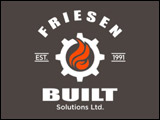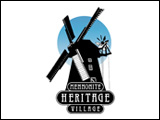The spectacle of the threshing demonstration, with the steam engine roaring and golden straw flying through the air, sparks interest and a crowd of spectators on festival days at Mennonite Heritage Village (MHV). And it’s no wonder. Seeing the machinery static, forlorn and sedentary, standing askew in the grass, just doesn’t cut it. Once coaxed into life, these machines transform into industrious agricultural monsters, too great and loud to ignore.
Our threshing demonstration is more than just a great show. It also interprets a significant aspect of Mennonite life on the farm in earlier times, where threshing – much like a hog-butchering bee or barn raising – was a community-wide event. Similarly, for our demonstration it takes five or six volunteers to operate the thresher, with another three or four from Steam Club ’71 to operate the steam engine, the source of power.
The threshing machine, powered by a belt from the steam engine, separates the grain kernels from the straw and chaff. It is a three-step process:
- Bundles of grain are pitched into the hopper, or feeder.
- These bundles are fed into the separator, a rapidly rotating set of blades that tears the bundles apart, then knocks kernels from the straw. The straw rack removes most of the straw, and the rest falls onto a series of progressively smaller shaking screens, removing more straw and chaff.
- In the cleaner, a stream of air blows the remaining straw and chaff away. The clean kernels are dropped into a waiting wagon, while the straw and chaff are blown out onto a straw pile.
Threshing is far from being the only agricultural endeavour at Mennonite Heritage Village. We have approximately seven acres divided into three fields. Crops are rotated so each year we have a field each of wheat, oats, and summer fallow. The land is cultivated, seeded, and harvested with significant involvement of some South East Implement Collectors Club members.
To break up the land, we use either the heavy 6-bottom plow, which requires the steam engine to pull it; a 3-bottom plow, pulled by a tractor; or the single-bottom breaking plow pulled by a team of horses.
After the crops are cut and bound into sheaves with a binder, the sheaves are stooked. (A stook, also known as a shock, is an arrangement of grain sheaves in a tapered construction designed to keep the grain heads off the ground and protect them from precipitation.) Last week, staff and volunteers stooked our field of oats. These stooks will now be stacked on wagons and stored until they can be threshed. We use oats here at the museum as feed, and it is eaten with gusto by our horses, cows, sheep and goats.
Thank you to our volunteers who coax these old machines into life each year and make the interpretation of Mennonite pioneering life possible. Check out our upcoming threshing demonstration at Fall on the Farm on September 7!



